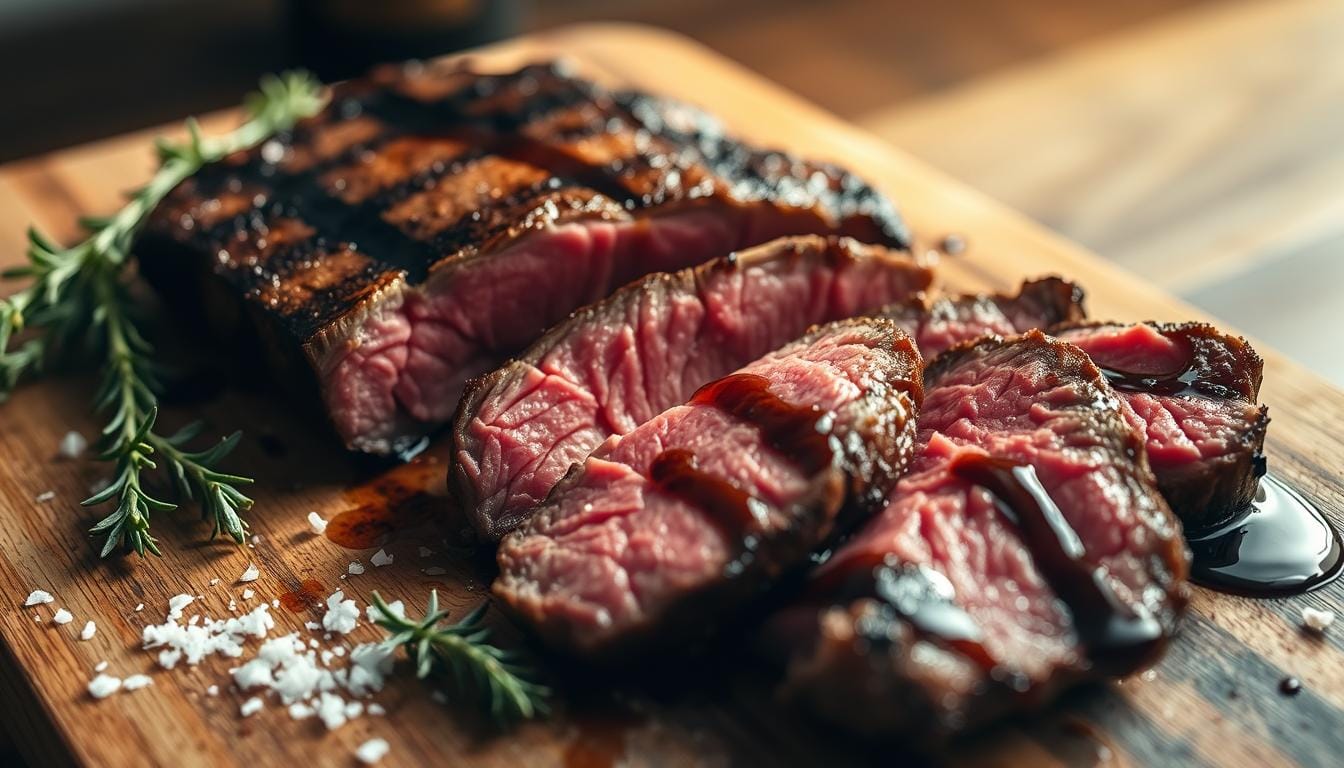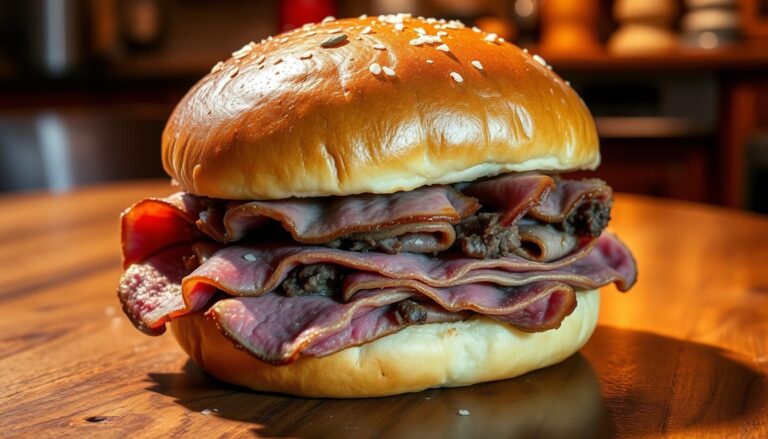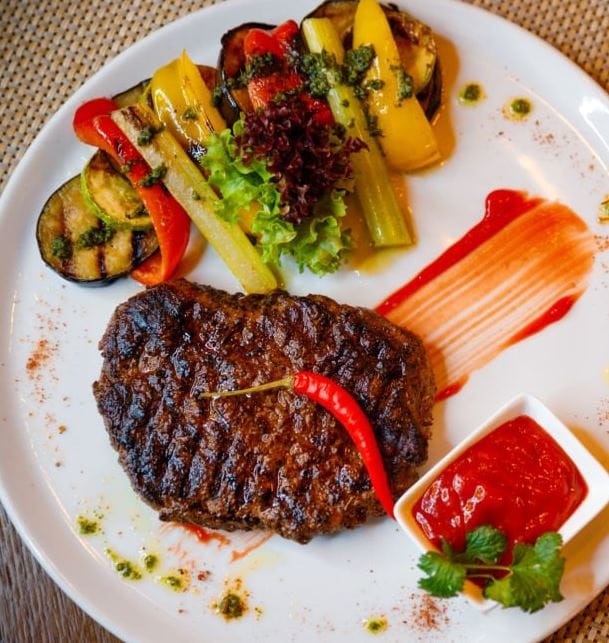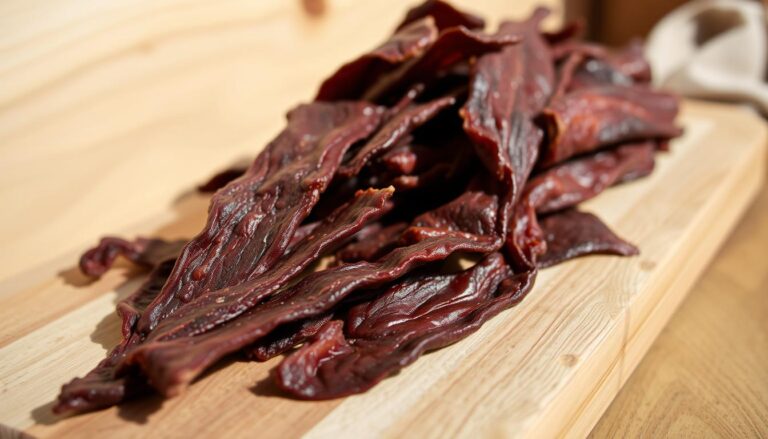Best Teres Major Recipe for a Steakhouse-Worthy Dinner at Home
Table of Contents
Best Teres Major Recipe for a Steakhouse-Worthy Dinner at Home
Imagine enjoying a tender, flavorful beef cut that’s both affordable and feels like a steakhouse meal. You’re about to learn how to make this culinary gem in your kitchen. The beef teres major is a hidden treasure that tastes amazing and is tender when cooked right.
This cut is known as the “butcher’s secret” because it offers a fancy dining feel without the high cost. By learning a simple teres major recipe, you can improve your cooking and wow your loved ones with meals that taste like they came from a restaurant.
Key Takeaways
- Discover the benefits of cooking with beef teres major.
- Learn how to select the perfect teres major cut.
- Master various cooking techniques to achieve tender results.
- Create restaurant-quality meals in the comfort of your own home.
- Elevate your culinary skills with simple yet impressive recipes.
What is Teres Major?
Discover the teres major, a cut of beef that’s gaining popularity. It’s known for its tenderness and rich flavor. This lesser-known cut comes from the shoulder area, similar to the more expensive beef tenderloin.
Understanding the Cut of Meat
The teres major is a small, cylindrical muscle from the chuck primal. It’s tender despite coming from a well-worked area of the animal. Its unique muscle structure makes it tender, without the high price of premium cuts.
Nutritional Benefits of Teres Major
Nutritionally, the teres major is great for health-conscious individuals. It’s high in protein and has a moderate fat content. This makes it juicy when cooked right. It’s also a good source of iron and B vitamins, adding to its nutritional value.
Flavor Profile and Cooking Characteristics
The teres major has a rich, beefy flavor thanks to its moderate marbling. This marbling adds to its tenderness and juiciness. It’s versatile in cooking methods like grilling, roasting, and sous vide.
When cooked right, the teres major steak recipe is impressive. Its tenderness and flavor are perfect for various dishes. From simple steak dinners to complex recipes like fajitas and stir-fries, it’s a favorite.
- Rich in protein and micronutrients
- Tender and juicy with moderate marbling
- Versatile cooking options
Choosing the Right Teres Major
Finding the perfect teres major is the first step to a delicious dish. Beef teres major is known for its tenderness and rich flavor. But, it’s not easy to find in regular stores.
To find teres major, you need to know where to look. Specialty butcher shops and upscale grocery stores often have it. Online meat shops are also great, providing many options and delivery right to your door.
Where to Buy Teres Major
Here are some places to find teres major:
- Specialty butcher shops
- High-end grocery stores
- Online meat retailers
- Local farmers’ markets
If you can’t find it in stores, ask your butcher. They might have it or suggest something similar.
Tips for Selecting Fresh Meat
Choosing a fresh, quality teres major is key. Here are some tips:
| Characteristic | What to Look For |
|---|---|
| Color | A bright cherry-red color means it’s fresh. |
| Marbling | Even marbling makes the meat taste better and feel softer. |
| Texture | The meat should feel firm, not soft or squishy. |
| Packaging | Little liquid in the packaging is good. Too much means it’s old or handled poorly. |
As
“The quality of the meat is just as important as the recipe you choose.”
, many chefs agree.
By following these tips, you’ll find the best teres major for your dish. Whether you’re an expert chef or just starting, the right cut makes a big difference.
Preparing Your Teres Major
A well-prepared teres major is key to a delicious meal. Here’s how to get it right. Before cooking, make sure to prepare your teres major well. This will bring out its natural flavors and texture.
Trimming and Cleaning the Cut
First, trim any extra fat and silverskin from your teres major. This is important because too much fat and silverskin can make the meat tough.
Step-by-Step Trimming Guide:
- Place the teres major on a clean, stable surface.
- Using a sharp knife, carefully remove any visible fat.
- Gently slice off the silverskin, taking care not to cut too much of the meat.
Recommended Marinades and Seasonings
Marinating your teres major can really boost its flavor. You can choose from many marinade recipes. They help tenderize or keep the meat moist.
Marinade Options:
- Acid-Based Marinades: Use lemon juice or vinegar to tenderize the meat.
- Oil-Based Marinades: Use olive oil or other oils to keep the meat moist.
For seasoning, you can go simple with salt and pepper or try more complex spice blends. These can really enhance the teres major’s natural taste.
Seasoning Tips:
- Keep it simple with salt and pepper for a purist approach.
- Experiment with spice blends to find the flavor you enjoy the most.
Cooking Methods for Teres Major
Choosing the right cooking method is key to perfect teres major. You can use grilling, roasting, or sous vide to bring out its best. Let’s look at each method and how it affects the cut.
Grilling: Techniques and Tips
Grilling adds a smoky taste and tender texture to teres major. Start with high heat for a char, then use indirect heat to cook it through. This method gives a nice balance of flavors and textures.
Heat your grill to 400°F (200°C). Season the teres major and grill for 4-5 minutes on each side for medium-rare. Use a thermometer to check the meat’s internal temperature. It should be between 130°F – 135°F (54°C – 57°C) for medium-rare.
To avoid flare-ups, clean the grill and dry the meat. Rotate the meat 90 degrees after 2-3 minutes to get those perfect grill marks.
| Doneness Level | Internal Temperature (°F) | Grilling Time (minutes) |
|---|---|---|
| Rare | 120-125 | 3-4 per side |
| Medium Rare | 130-135 | 4-5 per side |
| Medium | 140-145 | 5-6 per side |
Roasting: Achieving Perfect Doneness
Roasting is great for even cooking and a flavorful crust. Preheat your oven to 425°F (220°C). Season the teres major and place it on a roasting rack in a pan.
Roast for 15-20 minutes per pound, or until it’s cooked to your liking. Use a thermometer to check the internal temperature. For medium-rare, aim for 130°F – 135°F (54°C – 57°C).
To get a tasty crust, sear the teres major in a hot pan before roasting. This step enhances the flavor and texture.
Sous Vide: A Modern Approach
Sous vide cooking offers precise temperature control. Season the teres major, then seal it in a bag. Cook in a water bath at 130°F (54°C) for medium-rare, 140°F (60°C) for medium.
Cooking times vary, but 1-2 hours is usually enough for teres major. After cooking, sear the meat in a hot pan. This adds texture and flavor, making the dish more appealing.
Mastering these cooking methods lets you prepare teres major to your liking. Whether you prefer grilling’s smoky flavor, roasting’s even cooking, or sous vide’s precision, you can achieve it.
Teres Major Recipes to Try
Now that you know how to cook teres major, it’s time to try some tasty recipes. Teres major is great for many cooking methods and flavors.
Classic Teres Major Steak
To make a classic teres major steak, season the meat with salt, pepper, and herbs. Heat a skillet over high heat, add oil, and sear the steak for 2-3 minutes each side. Then, use a butter-baste technique for extra richness.
Teres Major Fajitas: A Flavorful Twist
For teres major fajitas, cut the meat into thin strips and marinate it in lime juice, garlic, and chili powder. Cook the marinated teres major with bell peppers and onions. Serve it with warm flour or corn tortillas.
Teres Major Stir-Fry: Quick and Easy
Teres major stir-fry is perfect for a quick dinner. Slice the teres major into thin strips and cook it with your favorite stir-fry vegetables and sauce in a wok or large skillet.
| Recipe | Cooking Method | Prep Time | Cook Time |
|---|---|---|---|
| Classic Teres Major Steak | Pan-searing | 10 minutes | 15 minutes |
| Teres Major Fajitas | Grilling/Sautéing | 15 minutes | 20 minutes |
| Teres Major Stir-Fry | Stir-frying | 10 minutes | 10 minutes |
These recipes show how versatile teres major is. They offer something for every taste and occasion. Whether you want a classic steak, spicy fajitas, or a quick stir-fry, teres major will impress.
Pairing Sides with Teres Major
To make your teres major meal better, pick sides that match its rich taste.
Best Vegetables to Complement Your Dish
Choosing the right veggies can add texture, flavor, and color. Here are some great picks:
- Roasted Brussels Sprouts: A classic that goes well with teres major’s savory taste.
- Grilled Asparagus: It brings a nice crunch and a bit of bitterness to balance the richness.
- Sauteed Spinach: Cooked quickly with garlic, it’s both nutritious and tasty.
Delicious Potato Side Dishes
Potatoes are great because they can be made in many ways to go with teres major. Here are some ideas:
| Potato Dish | Description |
|---|---|
| Herb-Roasted Fingerlings | Tender fingerling potatoes roasted with herbs like rosemary and thyme. |
| Creamy Mashed Potatoes | A classic comfort food that pairs well with the tender teres major. |
| Twice-Baked Potato Gratin | A rich and creamy potato dish that’s sure to impress. |
Creative Salad Ideas
Salads can offer a refreshing contrast to teres major’s richness. Try these:
- Grain-Based Salads: Quinoa or farro salads with roasted veggies are nutritious.
- Warm Vegetable Compositions: A mix of roasted or grilled veggies served warm.
- Bright and Acidic Salads: Green salads with citrus vinaigrette can cut through the richness.
By picking the right sides, you can make a memorable meal with teres major at the center.
Serving Suggestions for Teres Major
To truly enjoy Teres Major, how you present it matters a lot. A beautifully presented dish not only tastes great but also looks good. This makes eating more fun.
Presentation Tips for a Beautiful Plate
Presenting Teres Major right can make a big difference. Slicing against the grain is key for tender bites. Try for slices that are about 1/4 inch thick for the best taste and texture.
- Rest the Teres Major on a warm plate to keep it at the optimal temperature.
- Garnish with fresh herbs like parsley or thyme to add a pop of color.
- Consider a simple yet elegant arrangement, such as placing the sliced Teres Major in a fan pattern.
How to Serve Teres Major with Sauces
Sauces can really boost the flavor of Teres Major. Here are some top picks and how to serve them:
- Chimichurri: A classic Argentinean herb sauce that pairs well with grilled Teres Major. Serve it on the side or drizzle it over the top.
- Red Wine Reduction: Rich and flavorful, this sauce complements the beefy taste of Teres Major. Pool it around the meat for a sophisticated look.
- Béarnaise: For a luxurious touch, béarnaise sauce is an excellent choice. Serve it on the side to allow guests to help themselves.
When serving with sauces, aim to balance flavors and textures. The goal is to boost the Teres Major without overwhelming it.
Common Mistakes to Avoid
To make sure your teres major recipe is tender and tasty, watch out for these common mistakes. Cooking teres major is easy if you know what to avoid.
Overcooking the Cut
One big mistake is overcooking teres major. This meat can quickly become tough and dry if not watched closely. Use a meat thermometer to check the internal temperature.
For medium-rare, the temperature should be between 130°F and 135°F. Remember, the temperature will rise a bit after resting, known as carryover cooking.
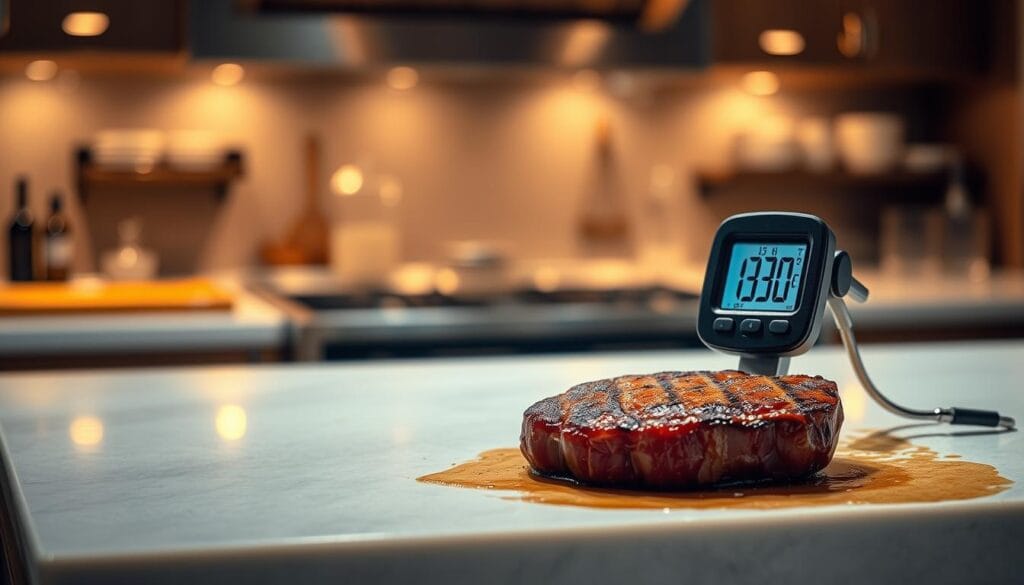
Don’t press down on the meat with your spatula while it’s cooking. This can squeeze out juices and make it dry. Let it cook undisturbed until it’s time to flip it.
Ignoring Essential Seasoning
Seasoning is key to bringing out the best flavor in your teres major. A common mistake is under-seasoning or adding salt too late. Salt enhances the meat’s natural flavors and helps keep it moist.
Don’t forget to season the meat liberally. This will improve the flavor. You can also use garlic powder, paprika, or herbs like thyme and rosemary to add more depth.
Skipping Rest Periods
Resting your teres major after cooking is essential. When meat is cooked, the proteins contract and juices are pushed to the surface. Resting allows the proteins to relax and juices to spread evenly, making the meat tender and juicy.
The resting time varies based on the cut size and cooking method. Generally, a teres major should rest for at least 5 to 10 minutes before slicing. To keep it warm, tent it loosely with aluminum foil.
Storing and Reheating Leftovers
Enjoying your Teres Major steak to the fullest means knowing how to store and reheat leftovers. The right steps keep your steak tender and tasty, even after the first meal.
Proper Storage Techniques
To keep your leftover Teres Major fresh, cool it down fast and store it in an airtight container. Use a vacuum sealer or a ziplock bag, squeezing out air before sealing. Refrigerate it at 40°F (4°C) or below, within two hours of cooking.
Refrigeration Guidelines: Place the Teres Major in the coldest part of your fridge, usually the bottom shelf. It’s best eaten within 3 to 4 days.
For longer storage, freeze it. Wrap the steak in plastic wrap or foil, then in a freezer-safe bag. Frozen Teres Major lasts up to 3 months. Thaw it in the fridge overnight before eating.
Best Ways to Reheat Teres Major
Reheating your Teres Major right is key to keeping its quality. Don’t use the microwave as it can make the steak tough and unevenly heated.
Oven Reheating: Preheat your oven to 200°F (90°C). Put the Teres Major on a baking sheet, cover loosely with foil. Heat until it reaches your desired doneness. This method warms the steak gently without overcooking.
Sous Vide Reheating: Sous vide reheating is perfect for precision. Place the steak in a sous vide water bath at your desired temperature. Let it reheat slowly for even heating.
Quickly searing the steak in a hot pan after warming it is also effective. This method refreshes the outside while warming the inside.
“The art of cooking is not just about following a recipe; it’s about understanding the nuances that make a dish truly exceptional.” –
By following these tips, you can enjoy your Teres Major steak fully, even as leftovers. Whether reheating in the oven, sous vide, or with a quick sear, the goal is to keep the steak tender and flavorful.
Teres Major Alternatives
Looking for other cuts of beef can be exciting. You might find new favorites that are tender and tasty. If you can’t find teres major or want to try something new, there are great substitutes.
Other Affordable Cuts of Meat
Consider flat iron steak, hanger steak, or chuck eye as alternatives. They are tender and flavorful, but each has its own unique taste.
- Flat Iron Steak: It’s tender and full of flavor, coming from the shoulder. Perfect for grilling or pan-searing.
- Hanger Steak: Known for its bold taste and soft texture. Great for high-heat cooking like grilling.
- Chuck Eye: Similar to the ribeye, it has a rich beef taste and tender feel. Ideal for grilling or roasting.
When swapping teres major for these cuts, think about their fat and texture. For instance, if grilling teres major, adjust cooking time based on the new cut’s thickness and fat.
How to Substitute in Recipes
Substituting teres major in recipes needs some tweaks. Here are tips for the best results:
- Change cooking times based on the new cut’s thickness and fat.
- Adjust seasonings to match the flavor of the substitute cut.
- Choose the right cooking method for the cut. Some are better grilled, while others roast or pan-sear better.
Knowing the traits of these cuts and making a few tweaks can make a tasty beef teres major dish, even without the original cut.
Teres Major in Different Cuisines
Teres major is a versatile cut that can be used in many international dishes. Its tender nature and rich flavor make it perfect for trying out different cuisines.
Tex-Mex Influence with Teres Major
The Tex-Mex cuisine is famous for its bold flavors and spices. These flavors pair well with teres major. You can use it in carne asada, beef enchiladas, and Texas-style beef fajitas.
To make it, marinate the teres major in a mix of spices. Use cumin, chili powder, and garlic. Then, grill or roast it to perfection.
Asian Fusion Recipes
Teres major also works well in Asian fusion recipes. For Korean-style bulgogi, marinate it in soy sauce, sugar, and sesame oil. Then, grill it.
Or, slice the teres major thinly for a Japanese-inspired tataki. Sear it on the outside and serve it rare on the inside.
| Cuisine | Recommended Dish | Key Ingredients |
|---|---|---|
| Tex-Mex | Carne Asada | Cumin, Chili Powder, Garlic |
| Asian Fusion | Bulgogi | Soy Sauce, Sugar, Sesame Oil |
| Asian Fusion | Tataki | Soy Sauce, Wasabi, Sesame Seeds |
By using teres major in these diverse cuisines, you can make many delicious dishes. These dishes show how versatile this exceptional cut of meat is.
The History and Origin of Teres Major
Did you know the teres major, a cut of beef few know, is now a favorite in cooking? Its history is quite interesting.
This cut was once overlooked. But, new ways of cutting meat and changing tastes have made it popular in the US.
Cultural Significance in American Cooking
In the last few decades, the teres major has become a hit. It’s known for being tender and flavorful. Chefs and food lovers enjoy its versatility and taste.
The trend of eating locally and using the whole animal has also helped the teres major shine.
Evolution of Teres Major in Modern Cuisine
Top chefs and cooking shows have highlighted the teres major. It’s now seen in many dishes. Social media has also boosted its popularity, with people sharing their favorite recipes.
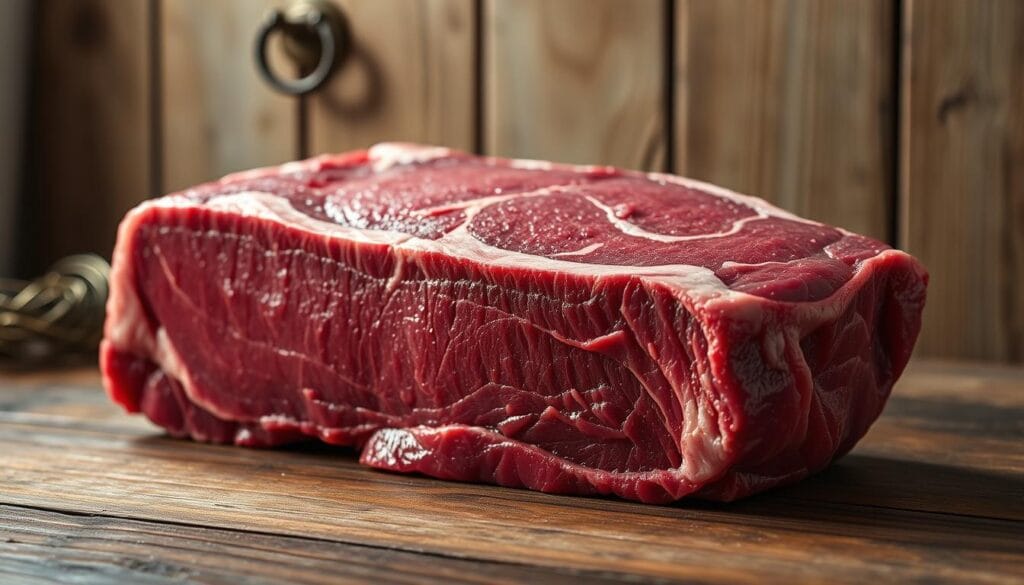
Now, the teres major is celebrated for its unique qualities. It shows a shift towards valuing less-known meats.
Tips for Cooking Teres Major Like a Pro
Cooking teres major to perfection needs focus and the right tools. You must pay attention to temperature control and resting time.
Utilizing a Meat Thermometer
A meat thermometer is key for cooking teres major. It gives you a precise internal temperature reading. This ensures your meat is cooked just right.
For teres major, use a digital or probe thermometer. The ideal internal temperatures are: 125°F for rare, 135°F for medium-rare, 145°F for medium, and 150°F for medium-well.
| Doneness | Internal Temperature |
|---|---|
| Rare | 125°F |
| Medium-Rare | 135°F |
| Medium | 145°F |
| Medium-Well | 150°F |
Importance of Resting Time
After cooking, let the teres major rest. This makes the meat tender and juicy. A resting time of 5-10 minutes is best, with the meat loosely covered with foil.
“Resting is a critical step that can make or break the quality of your teres major. It’s not just about letting it sit; it’s about allowing the meat to retain its juices and tenderness.”
Don’t make common mistakes like not covering the meat or not resting it long enough. These can make the meat dry and tough.
Popular Teres Major Products
The right tools and ingredients can make a big difference in your beef teres major cooking. To get a top-notch teres major steak recipe, picking the right seasoning blends and cookware is key.
Recommended Seasoning Blends
For a tasty teres major, many seasoning blends are available. A steak rub that matches the meat’s natural taste is a good choice. Montreal steak seasoning and garlic herb blends are favorites. Or, you can make your own mix with paprika, thyme, and rosemary.
For homemade seasoning, mix paprika, garlic powder, salt, and black pepper in equal parts. Add a bit of cayenne pepper for extra spice.
Best Cookware for Teres Major
The right cookware can improve your teres major cooking. A cast iron skillet is great for a perfect sear. A grill pan adds nice grill marks. Carbon steel cookware is versatile, with good heat retention and distribution.
When picking cookware, think about both high-end and affordable choices. For cast iron, pre-seasoned skillets are easy to maintain. Grill pans with non-stick coatings make food easier to release. Regular care, like seasoning cast iron, keeps it in good shape and working well.
Frequently Asked Questions (FAQs)
To help you master Teres Major, we’ve compiled answers to some of the most frequently asked questions.
Cooking Temperature Guidelines
Cooking Teres Major to the right temperature is key for perfect doneness. The ideal cooking temperature depends on the method.
- For grilling, use direct heat at 450-500°F for a nice sear, or indirect heat at 325-350°F for more even cooking.
- When roasting, preheat your oven to 325-375°F, adjusting the temperature based on your desired level of doneness.
- For pan-searing, heat your skillet to medium-high heat, around 400°F.
- Sous vide cooking allows for precise temperature control; aim for 130-135°F for medium-rare.
| Cooking Method | Temperature Range |
|---|---|
| Grilling (Direct Heat) | 450-500°F |
| Grilling (Indirect Heat) | 325-350°F |
| Roasting | 325-375°F |
| Pan-Searing | Medium-High Heat (~400°F) |
| Sous Vide | 130-135°F (Medium-Rare) |
Determining Doneness
Knowing when your Teres Major is cooked to your liking is essential. Here are some methods to check for doneness:
- Use a meat thermometer to check internal temperatures: 130-135°F for medium-rare, 140-145°F for medium.
- The touch test: Press the meat gently; it should feel firm but yielding for medium-rare.
- Visual cues: Look for the appropriate color and texture based on your desired doneness.
- Cooking time: Adjust based on the thickness of the cut and the cooking method.
By following these guidelines, you’ll be well on your way to cooking Teres Major like a pro. Whether you’re experimenting with new recipes or perfecting your technique, understanding the basics of cooking this cut of meat will enhance your culinary skills.
Conclusion: Enjoying Your Teres Major Dish
Now you know how to cook teres major. Whether grilling or roasting, a well-cooked teres major steak can make any meal special.
Cooking Essentials
To cook teres major well, choose the right cut, season it right, cook to the right temperature, and let it rest. These steps will make your meal unforgettable.
Exploring Flavor Combinations
Don’t hesitate to try new marinades and seasonings for your teres major dish. Pair it with seasonal veggies or add Asian flavors to your steak recipe.
With this guide, you’re ready to make teres major a hit with your family and friends. So, get creative and enjoy the rich taste of this underappreciated meat.
FAQ
What is the best cooking temperature for teres major?
How do I know when teres major is done?
Should I marinate teres major?
How does the price of teres major compare to other cuts?
Is teres major suitable for special diets?
Can I grill teres major?
What are some recommended seasonings for teres major?
For more cooking tips, stay connected with us. We also recommend the cookbook Skinnytaste Simple: Easy, Healthy Recipes with 7 Ingredients or Fewer
For more Recipes about Steak ?
Did You try our recipe ?
There are no reviews yet. Be the first one to write one.
